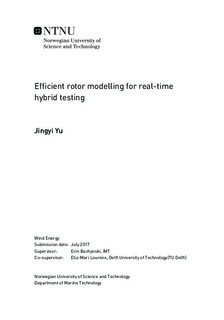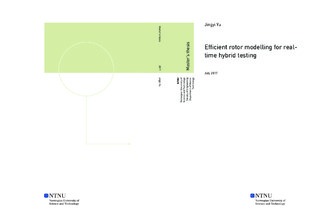| dc.description.abstract | Small-scale model tests in wave basins are important tools for validating numerical tools, evaluating system performance, and studying physical phenomena related to floating wind turbines. Hydrodynamic tests generally follow Froude scaling, but a consistent scaling of the wind turbine will result in a reduced Reynolds number compared to the prototype, which leads to generally poor aerodynamic performance. In order to solve such a Froude-Reynolds scaling conflict, a real-time hybrid model(ReaTHM) test was designed and carried out in SINTEF Ocean, illustrated in Figure(1). The aerodynamic loads were calculated numerically in real time based on the measured platform position. Then, the aerodynamic loads were applied to the physical model in the ocean basin through actuators. One disadvantage of the NOWITECH experiments in 2015 is that it used a rigid rotor model for the aerodynamic loads in order to minimize the calculation time. The purpose of this master s thesis project is to develop an efficient flexible structural model of the rotor, including the blade bending and torsion deflections, which is coupled to an aerodynamic code such as AeroDyn.
First, a flexible blade model is developed. The blade is assumed to be an Euler-Bernoulli cantilever beam. The stretch, flapwise bending, edgewise bending and torsion deflections are considered. The blade kinetic energy and potential energy are established using a set of hybrid coordinates. The equations of motion are obtained by Hamilton s principle. Finite element analysis is applied to calculate the blade natural frequencies and eigenmodes. Modal analysis is carried out in the time domain, coupled with AeroDyn to simulate the aerodynamic loads.
In the thesis, emulated ReaTHM testing is carried out, as shown in Figure(2). The tower, floater and mooring lines are modeled in SIMO-RIFLEX which can interact with the flexible blade model and the AeroDyn code through a dynamic link library(DLL). The computational efficiency of the presented flexible blade model is discussed. The set up of the emulated ReaTHM test is verified by decay tests and tests in irregular wind and wave.
hen, the effects of blade flexibility in the ReaTHM test are investigated. ReaTHM testing with rigid blades is more conservative for the considered semi-submersible concept. The effects of blade flexibility on the mean values is limited(1%). But the effects on the standard deviation(3-8%), especially the standard deviation of tower fore-aft bending moment are large, leading to large fatigue damage. Since 2015 NOWITECH ReaTHM test used a rigid tower model, using flexible blades model will not lead to a significant difference. However, if SINTEF Ocean plans to do the ReaTHM test with tension leg platform(TLP), it is recommended to use the developed methodology to see if flexible blades should be used.
Finally, a sensitivity analysis of limited actuations is carried out. In principle, all six components of simulated aerodynamic loads should be applied on the physical model. The sensitivity analysis shows that, for the semi-submersible in question, the aerodynamic heave force can be removed. | |

